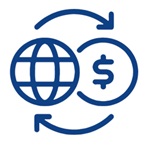
Andreas Park: You believe the scaffolding is emerging for “a historic disruption to our financial infrastructure.” Please explain.
Campbell Harvey: The key characteristics of traditional centralized finance are familiar to all of us: central banks control the money supply; financial trading is largely done by intermediaries; and borrowing and lending are conducted through traditional banking institutions. Decentralized finance, or ‘DeFi,’ seeks to build and combine open-source financial building blocks into products that maximize value for users.
DeFi will cover everything from exchange to savings and lending. It’s also about ‘tokenization’ — which I am very excited about. Say you drop into your local Loblaws to grab some items for dinner. When the time comes to pay, you will have choices to make: Your eWallet might include Canadian dollars as well as tokens that are collateralized with, for example, gold or IBM stock. Maybe you want to pay with your gold token, but the store doesn’t accept those. Seamlessly (and without any intervention from you), your e-wallet finds a decentralized exchange and the best possible rate is determined to exchange your gold token for whatever the store prefers.
One thing that is getting a lot of media attention is ‘nonfungible tokens’ (NFTs), which are already transforming the world of art. Art is a space that has historically been plagued by very powerful middlepeople who have made it difficult for artists to make any money. With NFTs, artists can go directly to the people who enjoy the art. This will be transformational for many industries, I believe, including gaming, ticketing, legal documents, domain names and even fashion.
We have come full circle, because market exchanges started out with barter, and what I just described is also barter. We won’t actually need to carry ‘money’ in the traditional sense; value will be represented by a variety of tokens that people will be able to barter with.
Two key elements of the DeFi infrastructure are blockchains and cryptocurrency. Can you provide readers with a ‘Coles Notes’ definition of each?
Sure. Blockchains are software protocols that allow multiple parties to operate under shared assumptions and data without any institutional reason to trust each other. These data can be anything from the destination information for items in a supply chain to account balances for a particular token. Updates are packaged into ‘blocks’ and are ‘chained’ together cryptographically to allow an audit of the prior history. Blockchains are possible because of consensus protocols — sets of rules that determine what kinds of blocks can become part of the chain and therefore the ‘truth.’

Traditional finance contains layers of inefficiency that have removed
value from the average consumer. DeFi brings this value back.
The most popular application of blockchain technology is cryptocurrency — a token (usually scarce) that is cryptographically secured and transferred. Typically, digital objects are easily copied, but the scarcity of the token is what ensures its value. A single account can’t ‘double spend’ its tokens because the ledger keeps an audit of the balance at any given time, so the faulty transaction would not pass the verification process. The initial cryptocurrency model is the Bitcoin blockchain, which functions almost exclusively as a payment network, with the ability to store and transact bitcoins across the globe in real time.
Talk a bit about the role of ‘smart contracts.’
A smart contract is a crucial element of the DeFi infrastructure. It can create and transform arbitrary data or tokens on top of the blockchain to which it belongs, allowing the user to encode rules for any type of transaction. Smart contracts can be used beyond finance to include gaming, data stewardship and supply chain.
Currently, the biggest blockchain with smart contract capability is Ethereum, which you can think of as one giant computer with many applications (the smart contracts). Users are charged a ‘gas fee’ for each transaction — similar to the way driving a car requires gas, which costs money. Simple computations such as sending Ethereum’s native cryptocurrency, an ether (ETH), require minimal work to update a couple of account balances and thus have a small gas fee, while complex computations that require checking conditions across several contracts require more ‘gas’ and thus have a higher fee.
In terms of transparency, smart contracts provide an immediate benefit compared to centralized financial systems: All parties involved are aware of the capitalization of their counterparties and, to the extent required, can see how funds will be deployed. They can all read the contract and agree on the terms, eliminating any ambiguity. This transparency substantially eases the threat of legal burdens and brings peace of mind to smaller players who, in the current environment, can be abused by powerful counterparties through delaying or even withholding their end of a financial agreement.
Realistically, average consumers won’t understand the contract code — but they can feel secure due to the open-source nature of the platform and the ‘wisdom of the crowd.’ Over time, many of the clauses of traditional business agreements could be shifted to smart contracts.
In addition to greater transparency, you believe DeFi addresses several other inefficiencies of centralized finance. How so?
DeFi can handle transactions with a high volume of assets that would be a huge burden for a traditional firm. It does this by creating ‘dApps’ (decentralized applications) — reusable smart contracts designed to execute a specific financial operation and available to any user who seeks that type of service. For example, to execute a put option, regardless of the size of the transaction.
Users can largely self-serve within the parameters of the smart contract and of the blockchain the application lives on. In the case of Ethereum-based DeFi, the contracts can be used by anyone who pays the flat gas fee — currently around $3 for a transfer and $12 for a dApp feature such as leveraging against collateral. Once deployed, these contracts continually provide their service with near-zero organizational overhead.
The fact is, traditional finance contains layers of inefficiency that have removed value from the average consumer. The efficiency of DeFi brings this value back.
Who should be paying close attention to all of this over the next few years?
The most successful and scalable new technologies address problems that people already have; so to answer that, you only need to think about the ‘pain points’ in our current system: credit card fees, slow wire transfers and unfavourable exchange rates, to name a few. These frictions act like a tax and hamper economic growth. For example, suppose you want to buy some company stock. Currently, you have to send money to a broker and the broker completes the trade for you. But getting the money through the system might take two to five days. With DeFi, you just need to link your e-wallet to an exchange and you’re ready to go.
DeFi will reduce transaction costs and make transactions more efficient. Economists don’t agree on much, but one thing they do agree on is that reducing transaction costs is good for economic growth.
Do you think big financial institutions will embrace DeFi tools so they can offer these services at a lower cost than smaller start-ups?
Yes, that could definitely happen; but can you imagine pitching that idea to a major bank? ‘All you need to do is spend a huge amount of money on peer-to-peer technology in order to cannibalize the profits you are already making on, say, FX transactions.’ Even 20 years ago, the banks realized that what they were doing wasn’t sustainable. The current fintech applications that have been embraced reduce costs and make things much more efficient, but they can only go so far, because they’re using centralized finance architecture. DeFi entails abandoning that architecture and replacing it with direct peer-to-peer trading, so both the buyer and the seller get the best possible price. That’s where we are heading, and I think the banks realize this — as do most brokers, exchanges and insurance companies.
Today, as indicated, it can take days to settle a trade and get a stock in your name. That makes no sense and it’s because of all the middlepeople involved who are making money off these transactions. Decentralized financiers know there’s no need for a time lapse between the execution of a trade and the settlement of that trade: It should happen simultaneously. It is also the case in DeFi that if you have an asset to sell, you’ll be able to put it on NASDAQ, NYSE and the Toronto Stock Exchange. This will lead to healthy competition between the exchanges.
Coinbase already has a higher profit margin by an order of magnitude than the NYSE or NASDAQ. I imagine that must already be eating into brokerage revenue from retail investors. How do you see this playing out?
That is true, and it’s no surprise, because the retail investor has been re-energized. And not just in the crypto space. Certain fintech applications have made it easy for retail investors to own fractional shares. Even if you only have $100 to spend, you can be active in the market.
With DeFi, everyone is equal. It is a democracy where no one is called ‘client,’ ‘banker’ or ‘broker.’ Everyone is a peer, and it doesn’t matter if you are big or small. Coinbase is the most successful firm in the crypto space, but I should emphasize that it is a centralized exchange/broker — and as such, it will likely come under intense competition from decentralized exchanges.
It’s a bit like the Wild West out there right now. How do you see regulation evolving?
Until this space is regulated, we will continue to see ‘pump and dumps’ — whereby people attempt to artificially inflate the price of a particular token so they can sell theirs at a higher profit. We have certainly seen some of that. But if a regulatory environment is too harsh, it can kill innovation and send innovators fleeing elsewhere. We don’t want a scenario where someone comes up with a great new idea but is fearful of the regulations in Canada or the U.S., so they decide to open shop in the Cayman Islands. It’s a balancing act: Yes, regulators are there to protect people; but they can’t go so far that they reduce all the risk. If that’s what we want, we can all invest in Treasury bills. And we know what the return is on those!
Just think of all the possibilities in this space: We’re talking about financial democracy, increasing inclusion, reducing frictions and increasing economic growth—all of which are highly relevant today. Stifling innovation with overly strict regulations would be a big mistake.
What are some of the key risks posed by DeFi?
While DeFi can eliminate counterparty risk — by cutting out intermediators and allowing financial assets to be exchanged in a trustless way — like all innovative technologies, it involves risk. One area of risk involves a part of the DeFi infrastructure we discussed earlier: smart contract risk.
Smart contract risk can take two main forms: an error in the code or an attack focusing on a vulnerability in the code. Over the past decade, crypto-focused products, primarily centralized exchanges, have repeatedly been hacked. To be fair, many of these situations happened because of the poor security practices of these centralized companies. The fact is, DeFi is built on open-source code, and that gives attackers a much bigger playing field than what traditional financial institutions provide. Attackers don’t need to break into any system because everything is open and transparent.
Those with doomsday concerns should know that it would be extremely difficult for any actor or country to amass the network power required to derail the most widely used blockchains, such as Bitcoin and Ethereum. But as indicated, public blockchains are open systems: After the code is deployed, anyone can view and interact with it. The recent hacks of dForce and bZx demonstrate the fragility of smart contract programming; but auditing firms like Quantstamp, Trail of Bits and PeckShield are emerging to fill this gap.
Beyond democratizing finance, you believe DeFi is “a technology of inclusion.” How so?
One problem that is particularly important to me personally is the fact that our financial system is not very inclusive right now. My hope is that, as smart contract platforms move to more scalable implementations, a wide range of users will embrace them, mitigating one of the other major flaws of centralized finance: limited access.
Currently, 1.7 billion people in the world are ‘unbanked,’ which makes it extremely challenging for them to obtain loans or operate in the realm of e-commerce. And many more are ‘under-banked.’ Here’s an example of what that looks like: An entrepreneur in Toronto is seeking financing for a new small business, so she goes to her bank to pitch it. The loan officer agrees that the idea is great, and better yet, the projected return on investment is 20 per cent. But here’s what happens next: This loan manager, like so many others, would rather deal with one large client than 100 small ones. So he says to the entrepreneur, ‘I see you’ve got a credit card with us; I am willing to increase your credit limit to cover this financing.’ A remarkable amount of entrepreneurs are financed with credit cards — but because the interest rates can soar up to 24 per cent, many choose not to proceed with their business.

DeFi gives large, underserved groups direct access to financial
services, regardless of their wealth or geographic location.
These types of scenarios are very costly for our economies in the long term. We sorely need many more small businesses that return 20 per cent, because our economy is stuck in two per cent growth mode. In my opinion, this and some of the other financial frictions we’ve discussed are big contributors to this lethargic growth.
The fact is, DeFi gives large, underserved groups like the global unbanked population and small businesses that employ substantial portions of the workforce (nearly 50 per cent in the U.S.) direct access to financial services, regardless of their wealth or geographic location. Access to these new products is of critical importance in preventing widening wealth gaps and the resulting impact on the global economy should also be very positive.
If you were to advise young professionals, what should they do: Learn about DeFi and find a way to integrate it into an existing institution or jump in and join (or form) a start-up?
If you’re going to allocate your own or anyone else’s financial or human capital to this space, you first need to really understand it — and that is true for any investment. So first of all, dedicate some time to understanding how DeFi works. Taking a course is a great start, but recognize that you will need to continually reinvest in learning, because this space is changing by the day.
Most of my students don’t go to start-ups right away because they’ve got heavy debt to pay down. They often start off at a big bank or insurance company. But I always tell them: From the very first day you start your job, you need to be thinking about a strategy to jump. It’s just a question of when. Maybe you’ll stay 18 months, maybe two years. Once they start working at these institutions, they see firsthand how difficult change is.
With start-ups, change is very natural because they must continually pivot. People might think, ‘But if I go to a start-up, there is a much higher probability that the company will fail and I’ll lose my job.’ Obviously, there is a higher probability of failure with start-ups, but the people you’re interacting with are really innovative, energetic, high-quality people, and those connections can enable you to quickly transition to your next opportunity.
Remember, failure is a very important experience for businesspeople — if we learn from it. Having a résumé with a few failed companies on it often increases the probability that the next one is going to be really great — maybe even a unicorn. Basically, my message to young professionals is very simple: Be a disruptor, not a disruptee. 
Campbell Harvey is the J. Paul Sticht Professor of International Business and Professor of Finance at Duke University’s Fuqua School of Business , a Research Associate of the National Bureau of Economic Research and a Research Fellow at FinHub, the Rotman School’s Financial Innovation lab. He is the co-author of DeFi and the Future of Finance (Wiley, 2021). Andreas Park is a Professor of Finance at the University of Toronto, appointed to the Rotman School and the Department of Management at U of T Mississauga and Research Director at the FinHub.
Share this article: